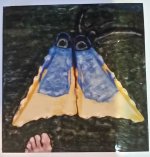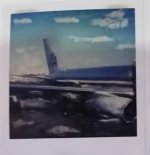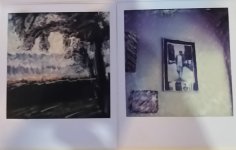hap
Well-known
G
Do you scan with a flatbed or some other process. Have any of you tried Film Lab, either in IOS or Android?
Regarding manipulation, in my ancient days I used the old gel emulsion for the SX 70 and pushed things around with makeshift "tools". It's an analog p;rocess that is very satisfying. To bad we still don't have it....but maybe in some ways the new film is not only sufficient but better if you are competent with digital methods. For me, digging into the print was therapy....especially since my career involves looking at computer based medical images 8 or more hrs/day.
I have some refrigerated sx 70 Impossible sitting around. Maybe I will just just use them and send the results to Impossible or Brooklyn Camera and let them make suggestions after seeing the artifacts and problems.
Do you scan with a flatbed or some other process. Have any of you tried Film Lab, either in IOS or Android?
Regarding manipulation, in my ancient days I used the old gel emulsion for the SX 70 and pushed things around with makeshift "tools". It's an analog p;rocess that is very satisfying. To bad we still don't have it....but maybe in some ways the new film is not only sufficient but better if you are competent with digital methods. For me, digging into the print was therapy....especially since my career involves looking at computer based medical images 8 or more hrs/day.
I have some refrigerated sx 70 Impossible sitting around. Maybe I will just just use them and send the results to Impossible or Brooklyn Camera and let them make suggestions after seeing the artifacts and problems.
Exploring RF
New at RF
The re-created SX-70 and 600 films from today's Polaroid (remember that these films were recreated by The Impossible Project, rebranded to Polaroid Originals, then re-branded once again to Polaroid over the course of the past 10 years, and are completely new and unrelated to prior film made by Polaroid that was discontinued in 2005.. ) are very similar: There are minor nuances in the color rendering and in the B&W microcontrast, but the differences are not huge. The SX-70 film is slightly better for longer exposure work if you have one of the cameras that supports time exposures (like the SLR670m, SLR670s, and SLR670x by MiNT)... it has just a little less reciprocity and seems to hold a longer tonal scale with long exposures past 4 seconds. By and large the 600 film is advantageous (presuming your camera is calibrated for ISO 600) due to the shorter exposures in normal light and less need for flash most of the time.
These films have been through quite a number of revisions over the past ten years ... The early versions of both B&W and color were extremely inconsistent both in ISO and color characteristics, aged out quite quickly when unrefrigerated, and were very very slow to develop and image.
The current versions are consistent, process to an image in a reasonable amount of time (the B&W is quicker and I can tell whether my exposure is on target in 5-10 minutes (takes some experience for sure), the color takes a bit longer to get to that point; both continue to finalize in color and contrast over the course of about 24 hours). The B&W rendering is a good, medium to strong contrast look; the color on a properly exposed frame is quite good.
Both B&W and color are sensitive to the ambient temperature when processing, and like all instant film have rather limited latitude: figuring the 'best exposure' for a given scene and lighting situation takes some experience and experimentation as the film's latitude and dynamic range will certainly be less than most scenes. You have to be able to 'see' what is going to be lost, both in shadows and at highlights, and choose the exposure that will give you the results you pre-visualize. There's a knack to it. That said: For average, medium contrast scenes, the in-camera exposure meters are remarkably good!
Going beyond just the film:
Another point of variability is the cameras themselves. Most SX-70 and 600 cameras are quite old now ... shutters tend to slow down as they age if they aren't cleaned and lubricated, the older meters lose some of their calibration too. How much abuse they have withstood is also an issue. My original SX-70 camera was a coddled favorite owned from new by my uncle (bought in 1974...), who was a fairly knowledgable photographer himself. He never abused it and always kept it in good storage conditions ... As a result, although it has never been serviced, it responds almost identically to different lighting situations as my overhauled and upgraded SLR670 series cameras from MiNT. Other SX-70s I had in the past did not fare as well and produced exposures with a wide variation in different lighting, even from shot to shot in the same lighting.
The modern era with digitization of the images opens up further possibilities for image processing and enhancing what instant film can do. I usually don't like to manipulate the Polaroid images too much, prefer to get it right in the original print as best possible, but there are cases where scanning with a good camera or scanner and then working the image with image processing has created something well beyond what the film and camera could achieve on their own.
I've been shooting Polaroid from ages past to the present, and shoot with it regularly. I'm now at the point where I can get 8 good frames out of a pack of the modern film pretty consistently and reliably, unless I get sloppy and don't stop to think about each exposure. And still I am sometimes surprised—in both directions! I know my cameras well because I use them often, and I study my results after every session to see where I made mistakes, try to remember and not make the same ones too often in the future. For me, this is fun and challenging. And I love the way the photos look when it all comes together.
G
I also have an old SX-70 camera my nephew gave me several years ago. He told me to "do a project or something". I ended up diving healing into MiNT Cameras, then large format, 35mm, now back again to instant. All his fault!
But to your point, that journey taught me much about exposure that makes this go round with instant more likely to be satisfying!
Thanks for the lowdown on SX-70 vs. 600.
hap
Well-known
hap
Well-known
hap
Well-known
hap
Well-known
having given some consideration on how proceed. Other than straightening out things with the SX 70, I have the hankering for the 149$ graflok compatible adapter from Lomo to use my Crown Graphic and Fujifilm Instax Wide. IT's kind of a kludge but it looks like possible fun. Unfortunately not a setup that allows for "Weegie" type street work.
Exploring RF
New at RF
having given some consideration on how proceed. Other than straightening out things with the SX 70, I have the hankering for the 149$ graflok compatible adapter from Lomo to use my Crown Graphic and Fujifilm Instax Wide. IT's kind of a kludge but it looks like possible fun. Unfortunately not a setup that allows for "Weegie" type street work.
I got the LomoGraflok, and I like it. Using with a full-on studio camera on tripod. Does require me to remove each time--at least for me--as the photo won't clear as it ejects from the rollers. But after testing, I'm planning to use it at a local nursing home so I have the old school vibe of a Sinar Norma with the gratification of Instant photos. With a little lighting--to address the limited dynamic range of the of Instax film--the portraits ought to be reliably satisfying.
hap
Well-known
It would be nice if you could calibrate the rangefinder and just kick out pictures. Maybe someday they will make a model that works similar to a roll back or a polaroid pack on a Graphic.
Godfrey
somewhat colored
G
Do you scan with a flatbed or some other process. Have any of you tried Film Lab, either in IOS or Android?
Regarding manipulation, in my ancient days I used the old gel emulsion for the SX 70 and pushed things around with makeshift "tools". It's an analog p;rocess that is very satisfying. To bad we still don't have it....but maybe in some ways the new film is not only sufficient but better if you are competent with digital methods. For me, digging into the print was therapy....especially since my career involves looking at computer based medical images 8 or more hrs/day.
I have some refrigerated sx 70 Impossible sitting around. Maybe I will just just use them and send the results to Impossible or Brooklyn Camera and let them make suggestions after seeing the artifacts and problems.
I usually scan with a copy camera approach, using either the Leica CL or Hasselblad 907x to do the scanning. Since Polaroid prints are positives, I just process the results as I normally do with digital captures. For negative captures, I do the same thing camera/copy-wise, and have developed my own inversion techniques with Lightroom Classic.
G
Share:
-
This site uses cookies to help personalise content, tailor your experience and to keep you logged in if you register.
By continuing to use this site, you are consenting to our use of cookies.




